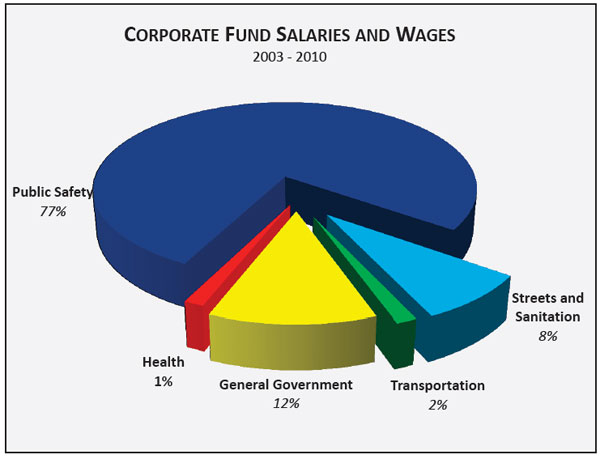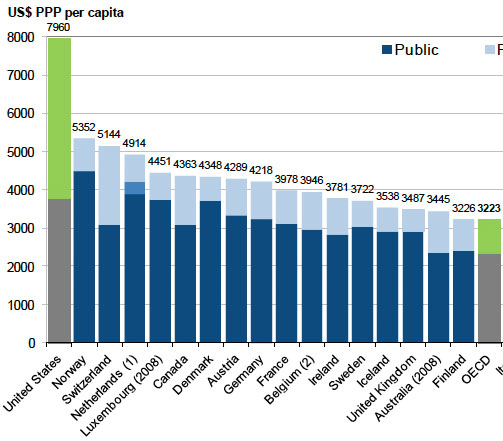Today’s big local story is Rahm Emanuel’s announcement that the city is in a $636 million hole, and that he won’t seek tax hikes or reserve drawdowns to fix it, leaving… nonspecifics:
Pressed for specifics on how he plans to tackle the problem, Emanuel demurred, speaking only generally about more of the “managed competition” that he is about to bring to household recycling. That means city employees will compete with private contractors to provide essential services like garbage collection — and whoever offers the best service for the lowest price will get the business.
Hal Dardick of the Trib notes:
Much of the budget imbalance results from long-term union contracts with locked-in raises, rising health care costs for workers and increased borrowing in recent years that brought higher interest payments.
But Hunter Clauss and Dan Mihalopolous of the CNC point out that much of that collective bargaining is with public safety employees—i.e. firefighters and cops—and cutting their ranks, salaries, and benefits is not politically easy:
“Some interest groups all feel that we should just go to revenue, and they can propose those ideas and they can tell the taxpayers why they should pay more now,” Emanuel said. “I say the hard choices, the hard choices, are fixing a system that is structurally imbalanced.”
What remains unclear is how Emanuel would balance the budget without addressing the costs of public-safety services. Police and firefighters make up roughly two-thirds of the city’s payroll.
The unionization numbers are pretty dramatic when you break them down. From the 2011 Annual Financial Analysis (PDF; emphasis mine):
The City is a party to collective bargaining agreements with more than 40 different unions. The two bargaining units representing the largest number of City positions in 2011 are the Fraternal Order of Police and the Chicago Firefighters Union, currently with more than 17,000 combined sworn public safety positions. When the Police Captains, Lieutenants and Sergeants are included in the total, the number of public safety positions is 18,760, an increase from the total of 18,549 in 2003.
The next largest group of positions is associated with the Coalition of Union Public Employees (COUPE) which includes the majority of unions. This group represents 7,305 trades positions in 2011, down from 9,437 positions in 2003. The American Federation of State, County and Municipal Employees (AFSCME) is the third largest group with 4,186 positions in 2011 providing administrative support for the City, a decrease from 6278 positions in 2003. The fourth largest group is the Service Employees International Union (SEIU) which currently represents 2,396 public safety civilian positions, a reduction of 7 positions when compared to 2003.
[snip]
The City has steadily decreased its workforce across funds from more than 42,000 in 2003 to 36,500 total positions in 2011, a decrease of approximately 13 percent.
One segment of the City workforce that has not experienced reductions during this period is the sworn public safety workforce. This group has increased both in number and as a percentage of the total workforce, and now comprises more than 50 percent of total City employees and 51 percent of the unionized workforce.
In other words, the city actually has cut back on unionized positions (although the percentage of unionized workers has gone up from 87 to 90 percent from 2003 to 2011, but not nearly as much on cops and firefighters; according to the Reader‘s Ben Joravsky, "the 2009 budget accounted for 7,813 beat officers, the 2008 budget for 7,976. That was a jump over 2007, but the overall direction has been down. There were over 8,000 beat officers in 2000." Here’s what the spending looks like from 2003-2007:

And while the city has in fact reduced employee headcount, the savings have been wiped out by broader economic trends:
Total corporate fund personnel costs increased by 11.6 percent between 2003 and 2010, despite the reduction of the corporate fund workforce by more than 2,500 employees during that time. Salaries and wage expenses, which are subject to collective bargaining, increased by 7 percent over that time period with an average salary of $64,000 per employee in 2003 increasing to $75,000 in 2010. The largest share of this increase has been in the cost of benefits which have increased by 37% since 2003. When the benefit cost is included, the average cost per employee increases from $74,700 in 2003 to $91,000 in 2010.
In other words, while city personnel have seen a modest salary increase, it doesn’t compare to the expense of benefits. Which ties into broader problems that the city can’t really fix on its own:

That’s from a 2011 OECD report (PDF) showing health-care costs per capita in different countries. If you aren’t a visual person:
Health spending accounted for 17.4% of GDP in the United States in 2009, by far the highest share in the OECD, and almost eight percentage points higher than the OECD average of 9.5%. Following the United States were the Netherlands, France and Germany, which allocated respectively 12.0%, 11.8% and 11.6% of their GDP to health.
The United States spent 7,960 USD on health per capita in 2009, two-and-a-half times more than the OECD average of 3,223 USD (adjusted for purchasing power parity). Following the United States were Norway and Switzerland which spent over 5,000 USD per capita. Americans spent more than twice as much as relatively rich European countries such as France, Belgium and the United Kingdom.
And this is a fairly new development. As Ezra Klein noted in "The Three Most Important Health Care Graphs in the World":
Note that in the 1970s, we were approximately equal to the rest of the world. It’s really in the ’80s and ’90s that the gap between us and everyone else opened up.
I’m still puzzling over the city’s Annual Financial Analysis, but it’s worth keeping that in mind as the city talks about what it’s spending and what it’s cutting—it’s hard to separate some parts of the budget from national factors.


